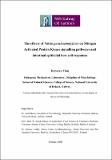| dc.description.abstract | Vibrio parahaemolyticus is a gram negative bacterium that is found in marine and estuarine environments. Although found amongst the commensal flora of shellfish, V. parahaemolyticus is a potent human pathogen. Consumption of V. parahaemolyticus results in gastroenteritis characterised by severe diarrhea and stomach cramps. There are a number of virulence factors associated with this pathogen, including two haemolysins and two Type Three Secretion Systems (TTSS-1 and TTSS-2). Upon infection of host gastrointestinal cells, V. parahaemolyticus has been shown to induce cell rounding, actin cytoskeleton disruption, autophagy and an increase in paracellular permeability followed by cell lysis. In addition, infection with V. parahaemolyticus is associated with enterotoxicity, the accumulation of fluid in the intestine. In order to better understand the mechanisms of infection, this study determined the role of host Mitogen Activated Protein Kinase (MAPK) cascades in this process. It was observed that V. parahaemolyticus infection results in the activation of JNK, ERK and p38 MAPK signalling pathways via a TTSS-1 dependent process requiring the effector protein VP1680. Use of chemical MAPK inhibitors indicated that JNK and ERK pathways play a role in both autophagy induction and the cell lysis observed following infection with the bacteria. TTSS-1 was required for both autophagy induction and cell lysis with VP1680 playing a role in these processes. Similarly, MAPKs were shown to be involved in translocation of the bacteria across the enterocyte monolayer. In contrast, changes in cell morphology, disruption of the paracellular permeability and passage of V. parahaemolyticus across M cells occurred independently of MAPK activity. Similarly, while TTSS-1 was required for disruption of the transepithelial resistance and cell rounding, VP1680 did not appear to play a critical role in this process. Passage of V. parahaemolyticus across the intestine occurred independently of the bacterial TTSS during the early stages of infection, however at later stages there appears to be a role for the TTSS. These data suggest that V. parahaemolyticus infection occurs via two or more distinct mechanisms, with one process being MAPK-dependent and the other being MAPK-independent. | en_US |


